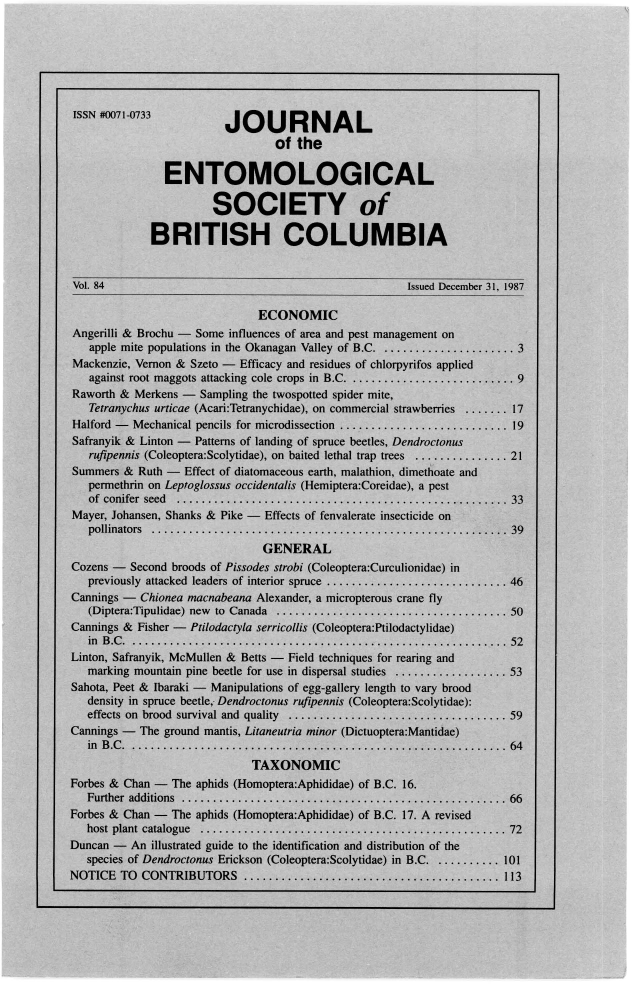Effects of fenvalerate insecticide on pollinators
Abstract
Susceptibility to fenvalerate sprays was greatest for the alfalfa leafcutting bee, <i>Megachile rotundata</i> (Fabr.); least for the honey bee, <i>Apis mellifera</i> L., and intermediate for the alkali bee, <i>Nomia melanderi</i> Cock. Low temperatures increased the residual toxic effects of fenvalerate to honey bees. Fenvalerate at 0.22 kg Al/ha had low residual hazard to bees after one day under Pacific Northwest conditions. Field tests of fenvalerate on blooming alfalfa, pollen-shedding corn, and blooming red raspberry resulted in reduced bee visitation and low to moderate adult bee mortality.
References
Atkins, E.L., D. Kellum, and K.W. Atkins. 1981. Reducing pesticide hazards to honey bees: Mortality prediction techniques and integrated management strategies. Univ. Calif. Leaflet 1883. 23 pp.
Clinch, P.G. 1971. A battery-operated vacuum device for collecting insects unharmed. NZ Entomol. 5:28-30.
Duncan, D.B. 1951. A significant test for differences between marked treatments in an analysis of variance. VA J. Sei. 2:171-189.
Johansen, C.A., D.F. Mayer, J.D. Eves, and C.W. Kious. 1983. Pesticides and bees. Environ. Entomol, 12(3):1513-1518.
Mayer, D.F. and C.A. Johansen. 1983. Occurrence of honey bee (Hymenoptera: Apidae) poisoning in eastern Washington. Environ. Entomol. 12(2):317-320.
Mayer, D.F., C.A. Johansen, J.D. Lunden, and Lora Rathbone. (In press). Chemical stickers and bee mortality. Aner. Bee J. .
Moffett. J.O., A. Stoner, and R.M. Ahring. 1982. Effect of fenvalerate applications on honey bees in flowering alfalfa. Southwest. Entomol. 7(2):111-115.
Stoner, J.P., W.T. Wilson, and J.O. Moffett. 1984. Effect of long-term feeding of low doses of fenvalerate or fluvalinate in sucrose syrup on honey bees in standard-size field colonies. J. Georgia Entomol. Soc. 19(4):490-498.
Stoner, A., W.T. Wilson, and Jack Harvey. 1985. Honey bee exposure to beeswax foundation impregnated with fenvalerate or carbaryl. Amer. Bee. J. 125(7):513-516.
Downloads
Published
Issue
Section
License
Authors who publish with the Journal of the Entomological Society of British Columbia agree to the following terms:
-Authors retain copyright and grant the journal right of first publication with the work simultaneously licensed under a Creative Commons Attribution License that allows others to share the work with an acknowledgement of the work's authorship and initial publication in this journal.
-Authors are able to enter into separate, additional contractual arrangements for the non-exclusive distribution of the journal's published version of the work (e.g., post it to an institutional repository or publish it in a book), with an acknowledgement of its initial publication in this journal.
-Authors are permitted and encouraged to post their work online (e.g., in institutional repositories or on their website) prior to and during the submission process, as it can lead to productive exchanges, as well as earlier and greater citation of published work (See The Effect of Open Access).


